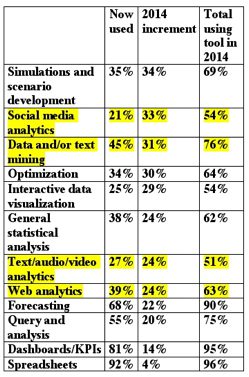Amid all the talk (from me and other business intelligence and analytics watchers) about end user departments – finance, marketing, and others – ignoring the IT department when it comes to BI/analytics, the rise of certain advanced analytics tools is reversing the trend.
A new survey by Harvard Business Review Analytic Services discovered strong demand over the next few years, at least for advanced analytics tools that finance, marketing or operations can’t use unless IT is seriously involved.
IT pros in the BI/analytics world can thank our old friend unstructured data. Incorporating emails, text messages, YouTube videos, Facebook posts, Word docs and other unstructured information into a data warehouse already populated with rows and columns of production, sales and personnel information has been a wish list item for almost a decade.
And it’s extremely difficult to do – spreadsheet jockeys who are wizards at nested formulas and linking Excel to DB2 or Oracle 8 aren’t ready to deal with the wide variety of data types that marketing, customer service and other departments need to examine.
The Spring 2012 HBR AS survey and October 2012 report shows that many of the tasks on the shopping lists of the more than 600 analytics users in the survey rely on incorporating unstructured data.
As the table below shows, roughly 21% of the 613 respondents are currently using social media analytics, but an additional 33% will be using analytics by 2014 to analyze tweets, blogs and other social media effluvia. Note that the increased interest in social media analytics even exceeds the ardor for web analytics, which was the hot button not too many years ago.
Source: Harvard Business Review Analytic Services
Indeed, contending with the demand for processing those incoming Word docs, PowerPoint presentations, emails, photographs and videos will challenge even the Extract, Transform and Load (ETL) experts within the IT department.
While there are a number of mature ETL tools, IT pros need to do a lot of research, and trial and error testing to find the right solutions for their organizations’ unstructured data torrent.
“IT will play a bigger role in enabling analytics infrastructure, especially with growing interest in integrating unstructured data,” notes Tapan Patel, Global Product Marketing Manager – Predictive Analytics and Data Mining, SAS.
As a business analytics veteran of 10 years, he noted in an interview about the survey data, “When it comes to new types of data sources, the data management support provided by IT is critical. These data sources require a closer look, especially in cleaning and preparing of unstructured data and integrating it with structured data for developing analytical models.”
Patel adds that analytics is a combination of art and science. The new division of labor for analytics within organizations, explains Patel, is for “IT to focus on the science of enabling analytics, while modelers focus on the art of delivering actionable insights that can drive proactive, evidence-based decision making within the organization.”
IT’s increased profile within the BI/analytics domains of the finance, marketing, operations and other functional areas comes at a time when leading organizations are dispersing their data scientists, analysts and other BI artists throughout those departments. Keeping all the statisticians behind closed doors in their own little department is as out of date as Windows XP.
Companies like Procter & Gamble and other leading edge analytics users are deploying their analytics artists as close to the lines of business as possible, because that’s where the direct financial impacts are more likely to occur.
While many consultants and vendors promote analytics centers of excellence within an organization to develop and then centralize deployment of best practices, the business’s need for direct analytics support will dictate a decentralized approach.
As usual, IT pros will be pushed and pulled as the organizational disputes drag on. However, the good news is that the rise of advanced analytics and the need to parse all of that unstructured data will keep IT pros very busy, though their org structures, or at least their dotted line relationships, will be volatile.
And we’ve all seen that before, right?



